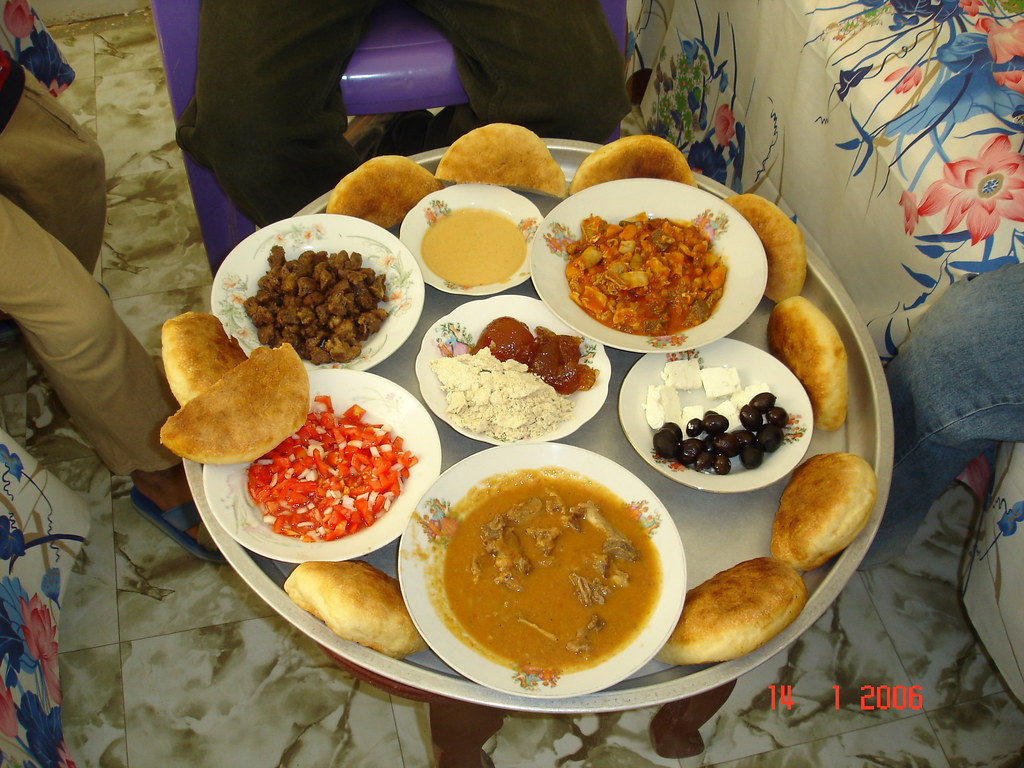Sudan is a very interesting country.One of the characteristics that makes Sudan so unique is it's humungous number of languages spoken there.The total number of languages used or spoken in Sudan is 142. Only 133 of those are currently spoken and 9 languages are not used anymore.The most used languages are Arabic, Tribal languages and educated people also speak English!
70% of Sudan's population follow believes of Sunni Islam, 25% Animist and Indigenous beliefs, and 5% follow Christianity!
Sudan's Daily Food:
Sudan's day usually begins' with a cup of tea. Breakfast is usually eaten at late morning, and it consists of beans, salad, liver, and bread. Millet one of Sudan's most common food is the staple food, and is prepared as a flat bread called kisra. Vegetables are prepared in stews or salads. Ful, a famous dish, consists of broad beans cooked in oil, cassavas and sweet potatoes are also very common. Nomads in the north mostly eat dairy products and meat from camels. Sheeps are usually killed for feasts or to honor a special guest. The intestines, lungs, and liver of the animal are prepared with chili pepper in a special dish called marara. At the Eid al-Adha, the Feast of the Great Sacrifice, it is a custom to kill a sheep, and to give part of the meat to people who cannot afford it themselves. The Eid al-Fitr, or Breaking of the Ramadan Fast, is another joyous occasion, and involves a large family meal. The birthday of the Prophet Muhammad, another important holiday is primarily a children holiday, celebrated with special desserts: pink sugar dolls and sticky sweets made from nuts and sesame seed.
Sudan's Arts
This is the National Theater in Khartoum, in which plays and other performances are hosted. The College of Fined arts, also in the Capital, has produced a number of well-regarded graphic artists.
Literature
The indigenous Sudanese literary tradition is oral, instead of written and it includes a variery of stories, myths and proverbs. the written tradition is based in the Arab north. Sudanese writers of these tradition are known throughout the Arab world. Tayeb Salih, is the country's most popular writer. Contemporary Sudanese poetry is a mixture of African and Arab influences.
The indigenous Sudanese literary tradition is oral, instead of written and it includes a variery of stories, myths and proverbs. the written tradition is based in the Arab north. Sudanese writers of these tradition are known throughout the Arab world. Tayeb Salih, is the country's most popular writer. Contemporary Sudanese poetry is a mixture of African and Arab influences.
 | ||||||||||
| This picture was painted by Rahsid Diam, a Sudanese famous artist. |
Graphic Arts.
Northern Sudan, and Omdurman are mostly known for ilver work, ivory carvings, and leather work. In the southern region, artisans produce carved wooden figures. In the desert regions of the country, most of the art is functional; such as swords and spears. Among contemporary artist, the most popular media are printmaking, calligraphy, and photography.
Performance Arts.
Music and dance are central to Sudanese culture plus it serves different and important purposes, both recreational and also religious. In the north, music reveals strong Arabic influence, and often involves dramatic recitations of verses from the Quran; which of course influences religion. In the south, the indigenous music relies heavily on drums and complex rhythms, expressing happiness & also enjoyment.
One ritual that plays an important role is the Zar, which is a ceremony intended to cure a women of possesion by spirits; it can last up to seven days.
Puppetry:
Puppetry is another Art the is really important in Sudan. The puppetry troupe, composed of 14 men and women aged 22-24, was formed through the Recovery and Rehabilitation Programmeme. On the streets as you walk by you can listen and hear to this fine Art!
Tourist Attractions:
Among the tourist attractions in Sudan are the Omdurman, which i a camel market and the Arab Souk.Another historical tourist attraction is the National Museum that contains archaeological treasures found from as much as 4000 BC. The main areas of archaeological interest in Sudan are found beside the Nile north of Khartoum. They include Bajrawiya, Naga and Meroe. The Dinder National Park is found in the southeast of Khartoum, and of course is one of the largest in the world. There you can find many species of wild animals, including lion, leopard, kudu, bushbuck and antelope.






No comments:
Post a Comment